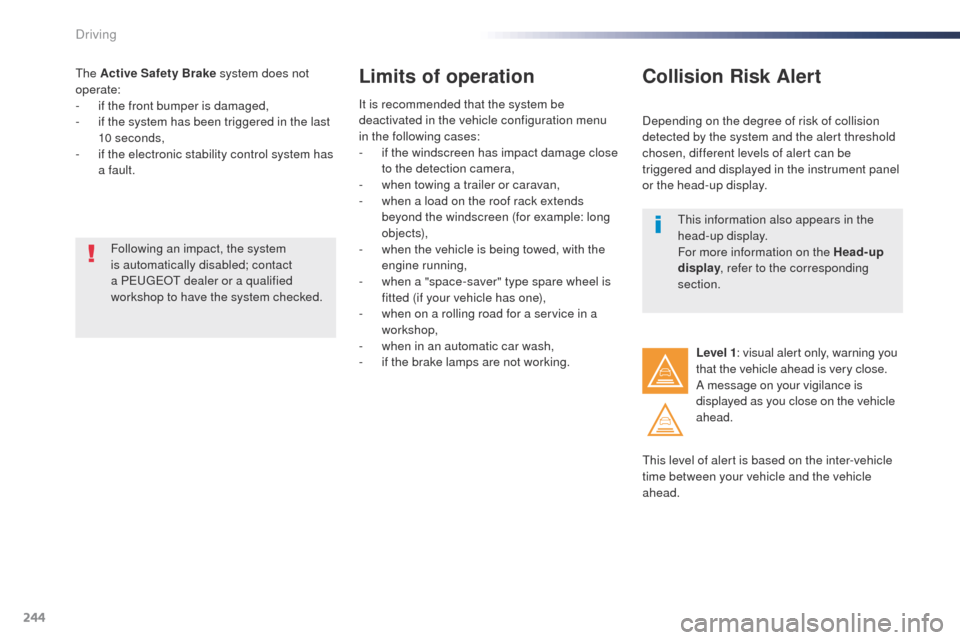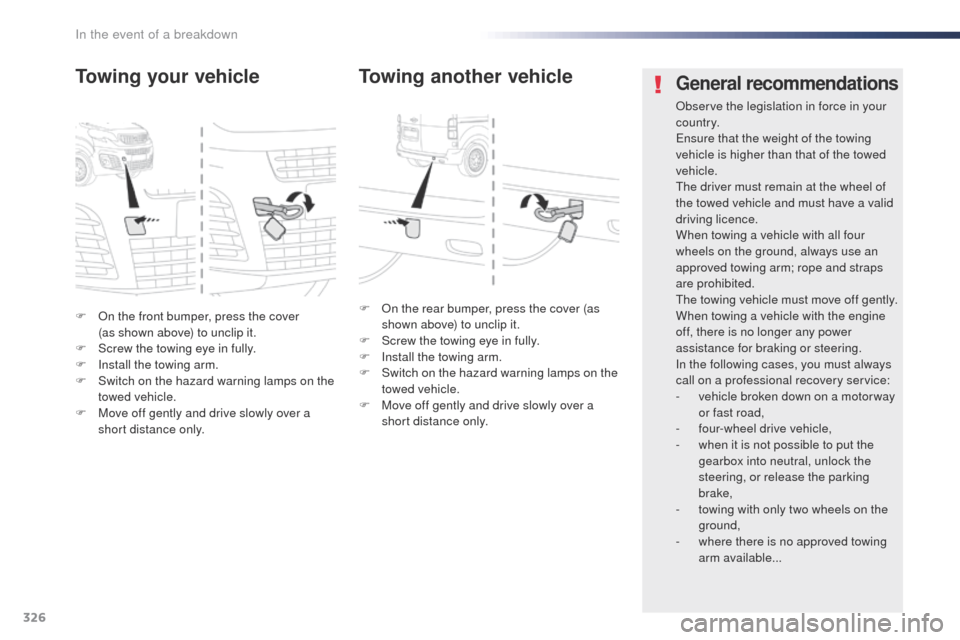Page 246 of 520

244
the Active Safety Brake system does not
operate:
-
i
f the front bumper is damaged,
-
i
f the system has been triggered in the last
10 seconds,
-
i
f the electronic stability control system has
a fault.Limits of operation
It is recommended that the system be
deactivated in the vehicle configuration menu
in the following cases:
-
i
f the windscreen has impact damage close
to the detection camera,
-
w
hen towing a trailer or caravan,
-
w
hen a load on the roof rack extends
beyond the windscreen (for example: long
objects),
-
w
hen the vehicle is being towed, with the
engine running,
-
w
hen a "space-saver" type spare wheel is
fitted (if your vehicle has one),
-
w
hen on a rolling road for a service in a
workshop,
-
w
hen in an automatic car wash,
-
i
f the brake lamps are not working.
Following an impact, the system
is automatically disabled; contact
a P
e
ugeot
dealer or a qualified
workshop to have the system checked.
Collision Risk Alert
Depending on the degree of risk of collision
detected by the system and the alert threshold
chosen, different levels of alert can be
triggered and displayed in the instrument panel
or the head-up display.
th
is level of alert is based on the inter-vehicle
time between your vehicle and the vehicle
ahead. Level 1
: visual alert only, warning you
that the vehicle ahead is very close.
A message on your vigilance is
displayed as you close on the vehicle
ahead.
th
is information also appears in the
head-up display.
For more information on the Head-up
display , refer to the corresponding
section.
Driving
Page 256 of 520

254
Operating fault
Have it checked by a Peugeot dealer or a
qualified workshop.
th
e system may suffer temporary
interference in certain weather
conditions (rain, hail...).
In particular, driving on a wet sur face
or moving from a dry area to a wet area
can cause false alerts (for example, the
presence of a fog of water droplets in
the blind spot angle is interpreted as a
vehicle).
In bad or wintry weather, ensure that
the sensors are not covered by mud,
ice or snow.ta ke care not to cover the warning zone
in the door mirrors or the detection
zones on the front and rear bumpers
with adhesive labels or other objects;
they may hamper the correct operation
of the system.
Depending on your vehicle's equipment:
With the touch screen
In the Driving
menu, activate/deactivate " Blind
spot monitoring ".
In the event of a fault, these warning lamps
flash.
th
e indicator lamp in this button
flashes and a message appears,
accompanied by an audible signal.
th
e state of the system remains in
memory on switching off the ignition.
th
e system is automatically deactivated
when towing with a towbar approved by
P
e
u g e o t .
High pressure jet wash
When washing your vehicle, do not
place the tip of the lance within 30 cm
of the sensors as otherwise there is a
risk of damaging them.
or
Driving
Page 263 of 520

261
Activation
Activation is automatic on engaging reverse.the function is displayed in the touch screen.
to c
lose the window displayed, press on the
red cross at the top left of the screen.
on d
isplay of the sub-menu, select one of the
four views:
"Standard view".
"180° view".
"Zoom view".
"A
u
to
m
o de".
You can choose the display mode at any time
by pressing on this area. Check the cleanliness of the camera
lenses regularly.
Periodically clean the reversing camera
with a soft dry cloth.
"AUTO mode"
this mode is activated by default.us
ing sensors in the rear bumper, the
automatic view allows a change from the rear
view to the view from above as an obstacle is
approached during a manoeuvre.
th
e system is automatically deactivated
when towing a trailer or carrying a
bicycle on the towbar (vehicle fitted with
a towbar installed as recommended by
the manufacturer).
Quick start mode
this mode displays, as quickly as possible, the
contextual view (left-hand part) and the view
from above the vehicle. High pressure jet wash (if muddy, for
example)
When washing your vehicle, do not
place the tip of the lance within 30 cm of
the camera lenses, as otherwise there
is a risk of damaging them.
A message is displayed advising you to check
your vehicle's surroundings before starting the
manoeuvre.
6
Driving
Page 271 of 520
269
towing a trailer
We recommend the use of genuine
Peugeot towbars and their harnesses
that have been tested and approved
from the design stage of your vehicle,
and that the fitting of the towbar is
entrusted to a P
e
ugeot dealer or a
qualified workshop.
If the towbar is not fitted by a
P
e
ugeot dealer, it must still be
fitted in accordance with the vehicle
manufacturer's instructions.
Your vehicle is primarily designed for
transporting people and luggage, but it may
also be used for towing a trailer. Driving with a trailer places greater
demands on the towing vehicle and the
driver must take particular care.
For more information on Driving
advice
, particularly when towing, refer
to the corresponding section.
7
Practical information
Page 289 of 520
287
Warning triangle (stowing)
Before leaving your vehicle to set up
and install the triangle, switch on the
hazard warning lamps and put on your
high visibility vest.
th
is safety equipment should be used in
addition to the hazard warning lamps.
Its presence in the vehicle is mandatory.
Placing the triangle in the
road
Refer to the manufacturer's instructions on
unfolding and assembly supplied with the
triangle. F
P
lace the triangle behind the vehicle, as
required by the legislation in force in your
c o unt r y.
th
e triangle is available as an
accessory; contact a P
e
ugeot dealer
or a qualified workshop.
tool box
Access
the tool box is located under the left-hand front
seat.
As a safety measure, the bars 1 and
2 prevent the box escaping from its
housing, if it is not correctly secured.
8
In the event of a breakdown
Page 290 of 520
288
Stowing
F Press the latches A and slide them inwards to release the box.
F
L
ift the box slightly then pull it as far as it
will go to take it past bar 1 .
F
t
h
en, lift the box upwards to take it past
bar 2 . F
un clip the fixings B on the cover, then
open it for access to the tools.
OpeningRemoving
Pull on the box to check that it is secure
in its housing.
F
o
f
fer up the box with the front inclined
upwards.
F
t
o t
ake it past bar 2 , push the box in and
down. F
t
o t
ake it past bar 1
, raise the box slightly
then push it fully in.
F
R
efit the cover on the box and clip the
fixings B . F
o
n
ce the box is fully home
in its housing,
push it against the floor carpet then slide
the latches A outwards to secure it.
In the event of a breakdown
Page 327 of 520
325
Battery capacity
Vehicle lengthRating in Ah
(Ampere hours)
C o m p a c t ( L1) 480
Standard (L2) 640
Long (L3) 720 / 800
Always replace the battery by one of
equivalent specification.
to w i n g
Access to the tools
the towing eye is stowed in the tool box. For more information on the Tool box ,
refer to the corresponding section.
Procedure for having your vehicle towed or
for towing another vehicle using a removable
towing eye.
If your vehicle is fitted with a manual
gearbox, put the gear lever into neutral.
If your vehicle has an automatic or
electronic gearbox, place the gear
selector at position N
.
th
e failure to observe this special point
may lead to damage to components
of the braking system and the lack of
braking assistance on restarting the
engine.
8
In the event of a breakdown
Page 328 of 520

326
F on the front bumper, press the cover (as shown above) to unclip it.
F
S
crew the towing eye in fully.
F
I
nstall the towing arm.
F
S
witch on the hazard warning lamps on the
towed vehicle.
F
M
ove off gently and drive slowly over a
short distance only.
Towing your vehicle
F on the rear bumper, press the cover (as shown above) to unclip it.
F
S
crew the towing eye in fully.
F
I
nstall the towing arm.
F
S
witch on the hazard warning lamps on the
towed vehicle.
F
M
ove off gently and drive slowly over a
short distance only.
Towing another vehicleGeneral recommendations
observe the legislation in force in your
c o unt r y.
en
sure that the weight of the towing
vehicle is higher than that of the towed
vehicle.
th
e driver must remain at the wheel of
the towed vehicle and must have a valid
driving licence.
When towing a vehicle with all four
wheels on the ground, always use an
approved towing arm; rope and straps
are prohibited.
th
e towing vehicle must move off gently.
When towing a vehicle with the engine
off, there is no longer any power
assistance for braking or steering.
In the following cases, you must always
call on a professional recovery service:
-
v
ehicle broken down on a motor way
or fast road,
-
f
our-wheel drive vehicle,
-
w
hen it is not possible to put the
gearbox into neutral, unlock the
steering, or release the parking
brake,
-
t
owing with only two wheels on the
ground,
-
w
here there is no approved towing
arm available...
In the event of a breakdown